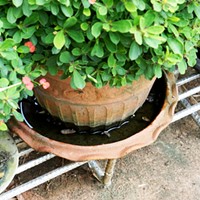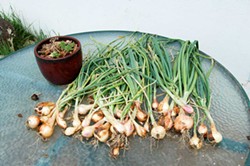[
{
"name": "Top Stories Video Pair",
"insertPoint": "7",
"component": "17087298",
"parentWrapperClass": "fdn-ads-inline-content-block",
"requiredCountToDisplay": "1"
}
]
I never realized how much growing up on the North Coast influenced my eating preferences until I traveled overseas to Belgium. In that part of the world, they eat salad as lettuce with mayonnaise, strawberries with white pepper and radishes dipped in salt. New flavor combinations made me appreciate garden delicacies in new ways. Many Europeans, including my Belgian host mother, grow their own produce. In honor of Bastille Day (French Independence Day) this July, we can follow our fearless French-speaking backyard garden friends to a delicious time.
Here on the home farm, we like to grow vegetables in groups based on the meal they're designed for. We're obsessed with salads and stir-fry because they're quick and easy choices for post work-day meals. Why not grow all these little stars together for a galaxy of flavor? The long bright days of July offer a great opportunity for sowing everything one could hope for in a refreshing salad or dreamy stir-fry. Once the starts grow to maturity, it only takes a few minutes to harvest farm-fresh ingredients for a world-class culinary experience. All of these plants are easy to grow and offer an abundant harvest.
Salad Bowl
Of any place to begin home food growing, the salad bowl is a great jumping off point. Whether it's for lunch, dinner or potlucks, everyone loves salad.
Two quick growing salad additions are sprouts and snow peas. A wide variety of sprout seeds can be purchased from natural food stores. After an overnight soak, sprouts placed in a sunny windowsill should be rinsed twice daily until they achieve desired salad topping size (usually about seven to 10 days). Homegrown sprouts cost a fraction of the store price and offer high nutrition and delicate texture. Snow peas can be easily grown from seed. They require something to climb on, such as a small trellis, scrap fencing material or even chicken wire. Their pretty white flowers signal pea development. Make sure to pick peas daily to boost production. Peas are happiest planted in small groups, wrapping around each other for extra support as they grow.
Here on the North Coast, we can grow lettuce in our sleep. Lettuce thrives in the cool coastal summer temperatures we enjoy. Many colorful varieties unavailable commercially such as Speckles, microgreens, Jester and Steamboat offer the home farmer the opportunity to explore lettuce land. On the home farm, variety is the spice of life; we like to alternate salad greens on the daily. In addition to lettuce, arugula, spinach and radicchio offer fine alternative choices and all can be planted right now. As our crisp greens grow, we clip the outside leaves, helping to keep plant growth compact and upright to lessen slug and snail activity.
Incorporating extra color with root vegetables offers interesting opportunity to explore home salad creation. Beets, carrots, and radish seeds can all be sown this month. Root veggies are tricky to transplant – they are best grown from seed on site. Beets can be eaten as a root or a dark leafy green - let the roots get large to experience all the plant has to offer. Carrot seeds can take up to 10 days to germinate, so keep watering the sown area gently with a watering can a couple times a day to keep the soil moist. Planting in coir medium (see Down and Dirty "Victory Garden" column, April 19, for the recipe) will keep the soil moist between waterings. A layer of compost will also boost seed growth. Radishes are quick to grow, providing crunchy and spicy snacks and the greens are also edible (though they require cooking). We like to fine grate all three raw for incredible color. Beets and carrots can also be parboiled and stored in the fridge for up to a week for quick salad additions.
Stir-Fry
Another easy way to eat out of the garden is by starting a stir-fry collection. Dark leafy greens such as kale, chard and mustard provide a base. All can be sown from seed or transplanted this month. Brassicas such as cabbage, broccoli, cauliflower and Brussel sprouts offer crispy texture. They can also be started now. These choices take up a little more space in the garden and require a bit longer than the dark leafy greens to achieve harvest size. Make sure to pick a broccoli variety that can be harvested multiple times, such as sprouting broccoli, broccoli raab, or Chinese broccoli. Also, since we're in the home garden, we can grow orange (flame star), purple (graffiti), green (Veronica) and white (Skywalker) cauliflower. Brussel sprouts create amazing vertical texture. The first time we grew them, they were attacked by mites and we were unable to enjoy them that year. Keep an eye out for these little pests and spray the plant down with soapy water at their first appearance.
A patch of scallions, leeks and garlic adds incredible gourmet flavor. All three can be planted now from seed. If you already have garlic going from last winter, keep an eye on the stalks. Once they're mostly dry, they're ready for harvest and curing. Just break up the soil around them with a pitchfork, gently dig the stalks up and place out in a sunny spot to let them dry completely. Braid up the ends and enjoy crushed garlic in every stir-fry.
Layering home grown vegetables in the pan or bowl provides joy and satisfaction. Whether cool or cooked, homegrown-bounty opportunities abound. Evening garden wind down time offers the perfect time for contemplating the independence of home food growing. Amusez-vous bien! (Enjoy yourselves greatly).
Katie Rose McGourty is the owner of Healthy Living Everyday at www.healthy-living-everyday.com.
Speaking of...
-

Lab Letdown, Health Disparities and Eating/Weeding Veggies
Jan 19, 2024 -

Burgers, Backpacks, Media and Weekend Recs
Sep 22, 2023 -

Gardening in the Gloom
Jul 6, 2023 - More »
more from the author
-
On Becoming A Flockster
What chickens bring to your garden
- Jul 30, 2020
-
Blackouts and Enchanted Gardens
- Nov 28, 2019
-
Getting Covered and Putting up Apples
And other tasks for October harvest
- Oct 11, 2019
- More »

































